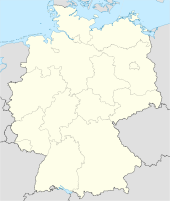- Neukloster
-
Neukloster Coordinates 53°52′N 11°41′E / 53.86667°N 11.68333°ECoordinates: 53°52′N 11°41′E / 53.86667°N 11.68333°E Administration Country Germany State Mecklenburg-Vorpommern District Nordwestmecklenburg Municipal assoc. Neukloster-Warin Mayor Frank Meier Basic statistics Area 27.49 km2 (10.61 sq mi) Elevation 30 m (98 ft) Population 3,950 (31 December 2010)[1] - Density 144 /km2 (372 /sq mi) Other information Time zone CET/CEST (UTC+1/+2) Licence plate NWM Postal code 23992 Area code 038422 Website www.neukloster.de Neukloster is a town in the east of the district of Nordwestmecklenburg, Mecklenburg-Western Pomerania, Germany. This town is the administrative center of the bureau Neukloster-Warin, which includes eight more communes.
Contents
Geography
Neukloster is located at the Neuklostersee (Lake Neukloster), which originates from the Ice Age. The area around Neukloster belongs to the outmost north-western part of the Sternberger Seenlandschaft (Seascape of Sternberg). Neukloster is approx. 45 km (28 mi) away from Rostock and approx. 20 km (12 mi) away from Wismar.
The villages Lübberstorf, Glasin, Zurow, Benz and Züsow border on Neukloster.
History
The history of Neukloster goes back to the Middle Ages, like most of the other places around. In 1170 the Kussinger Burg (Kussinger Castle) already existed in today's city limits of Neukloster. It is supposed that the center of the castle was located in the center of today's city center.
In the Middle Ages the Kloster Sonnenkamp (Sonnenkamp Convent) was located in the smaller village of Parchow. During this period, that area was hard-fought and it was exposed to the violence of the Middle Ages. The convent was relocated to Neukloster. This convent in Neukloster was first mentioned in 1219. The castle tumbled down with time, nevertheless the convent developed into a cultural and commercial center for this region. The convent was closed in the year of 1555. Its wealth and real estate went to the property of the Lords of Mecklenburg.
After Thirty Years' War, in 1648, Neukloster, Wismar and some closer places, fell under the lordship of Sweden. During this period of time, Neukloster was confronted with impecuniousness and balefulness, but after all, Neukloster endured this time until 1803. In that year, the Swedish occupation decided to lease Neukloster (and all other areas in Mecklenburg) to Mecklenburg-Schwerin for 100 years. After these 100 years, Neukloster and all other leased areas around, were annexed to Mecklenburg.
Neukloster became more important for the region, when the "Lehrerseminar" (seminar for teachers) moved from Ludwigslust to that small town, in 1862. Two years later, the "Landesblindenanstalt" (state's home for the blind) was founded in Neukloster. The population increased quickly, trade and industry were booming. In 1887, Neukloster was linked to the local railroad network.
In 1938, Neukloster received its town charter; the population doubled in the years after World War II, from 2,500 to almost 5,000 inhabitants. During the German Democratic Republic, 1949–1990, the landscape of Neukloster changed dramatically. Neukloster got a small town appearance. Many buildings were built, i.e. a campground, a movie theater, an old people's home, a stadium, schools, a kindergarten, the building of the Catholic Church and the market place.
Within the "Städebauförderung" (urban development sponsorship), Neukloster has been renovated since 1991.
Transport Connection
Neukloster is connected with the Bundesautobahn 20 (interstate #20). The Bundesstraße 192 (highway #192) (Wismar–Neubrandenburg) is only 3 km (1.9 mi) away from Neukloster. The railroad station is closed. To go farer distances, it is recommended to take the railroad station in Bad Kleinen or Rostock.
References
- ^ "Bevölkerungsentwicklung der Kreise und Gemeinden" (in German). Statistisches Amt Mecklenburg-Vorpommern. 31 December 2010. http://service.mvnet.de/statmv/daten_stam_berichte/e-bibointerth01/bevoelkerung--haushalte--familien--flaeche/a-i__/a123__/2010/daten/a123-2010-22.pdf.
Categories:- Towns in Mecklenburg-Vorpommern
Wikimedia Foundation. 2010.




